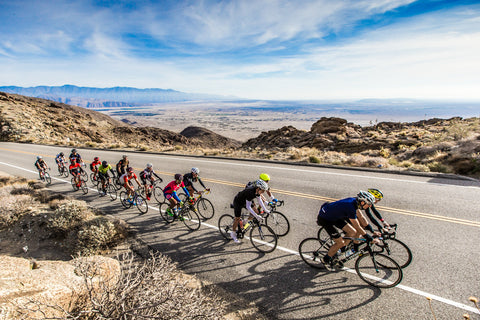by Brian Maslach
An important part of my training routine is strength training. It may not take up a lot of my overall training time, but as a masters athlete it's crucial to improving power, stability, and injury prevention.
Before I discovered endurance sports, I began strength training to improve my BMX racing and it eventually became my primary objective. Gym time was my jam and I looked forward to it as much as I currently look forward to a mountain bike ride. Because of this I had a strong foundation and developed a good sense of what worked best for me.

Kettlebells have become the most used tool in my strength routine.
Despite how effective strength training can be for endurance athletes, I see most people wasting their gym time. Whether it's ignoring the basics, focussing on ineffective movements, or trying to do advanced exercises to which they haven't adequately progressed, most endurance athletes aren't getting as much as they should from their efforts. Perhaps the biggest mistake is focussing on muscular endurance in the gym. Since most endurance athletes don't spend a lot of time strength training, we need to be focussed increase strength. Endurance work is usually best done outside the gym room.
For years the standard training recommendation for endurance athletes was to use weights that allow relatively higher repetitions (70% 1RM for 10-15 reps/set) than normally performed in strength training. However, researchers at University of Rome have shown that masters endurance runners are better served by training with heavier weights (85-90% 1RM for 3-4 reps).
The researchers concluded:
Taken together, the results of this preliminary study indicate that master endurance athletes seem to benefit from concurrent strength and endurance training because the rate of force development may be crucial for RE improvement, one of the major determinants of endurance performance.
While this study looked at runners, the same principles apply to all endurance athletes. The use of heavier weights was thought to result in greater neurological (nervous system) adaptation, as opposed the creation of new muscle tissue, allowing the subjects to use more of their strength potential.
My personal experience aligns with this study. I'm not trying to build bigger muscles, I just want greater strength to push harder on the pedals and to be better able to avoid injury.

Pushing a weighted sled is the most effective strength exercise I've found to improve cycling performance.
Those lifting heavier weights in the study didn't gain any more weight than those lifting lighter weights. In fact, neither group saw a change when compared to the control group, who didn't weight train, but continued running. The majority of us simply don't possess the genetics to gain appreciable muscle while continuing endurance work. The fear of bulking up from lifting "heavy" weights is thus unwarranted amongst endurance athletes. The majority of your time in the gym should be spent building as much strength as possible. Don't be afraid of challenging strength work.

Base endurance work will help keep you lean during the offseason.
If you're not experienced in the weight room, have a qualified strength coach instruct proper form and exercise selection. The potential for injury increases whenever improper technique is used, regardless of the amount of weight on the bar. Besides, throwing weights around with poor form is also less effective. No one cares how many pounds you have on the bar, so don't try to use more weight than you can handle to impress anyone.
If you're not already strength training, the early offseason period is the ideal time to start. And, if you have been strength training, this is also the perfect time to re-focus on and re-evaluate your routine.
Over the upcoming weeks, we'll present some of our favorite routines for maximizing your offseason effort to ride stronger than ever in 2023.
Lastly, to get the most from your gym time, you need to get the right nutrients. Beta Red Pre-Workout Formula before training and Recovery Protein afterward will help you come back stronger for your next workout.

Leave a comment